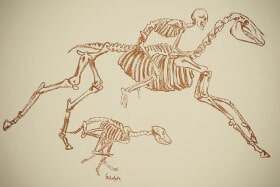- Pain management
- Reduced inflammation
- Enhanced physical performance
- Improved movement of joints associated with the spine
- Optimized input from the body to the brain and vice versa
- Better flexibility and balance
- Strengthen the immune system
- Improved quality of life

Veterinary Spinal Manipulative Therapy (VSMT) is commonly referred to as animal chiropractic. The nervous system relies on constant feedback between the brain and all parts of the body. The spinal cord is a critical communication pathway, similar to a highway, and carries all of the neurologic information into and out of the brain.
Every joint in the body needs movement to function properly. As joints move, joint receptors send information to the brain which is processed instantly and then the brain initiates new instructions to go out to the body. The spine is very intricate and every vertebra has a minimum of six joints associated with it. The joints between vertebrae allow our spine to perform a variety of complex movements including rotating, bending, flexing, and more. Restriction of this movement in the spine can create a cascade of events, affecting the entire body – muscles, nerves, blood vessels, joints, lymphatics, and more.
While the spine is similar in all mammals, there are anatomical and physiological differences that must be considered. Humans are bipedal, meaning we walk on two feet, and have longer legs than quadrupeds, animals who walk on four legs. The bipedal stance results in less torque and rotation in the spine than what we see in our pets. Thoroughly understanding these differences help make spinal adjustments safer for our pets.
What is a spinal adjustment?
The goal of a spinal adjustment is to restore proper function locally at the spinal motion unit. This helps to promote neuromodulation, which allows for better communication between the brain and body in both directions. A properly performed spinal adjustment is specifically directed at the individual spinal motion unit with restricted movement. A hand-directed high velocity, low amplitude thrust is applied to restore spinal movement.
Benefits of VSMT
There are many benefits when VSMT is performed in our pets. They may include:
When should VSMT be considered for our pets?
Spinal adjustments may be beneficial in cases involving:
- Lameness
- Neck, back, tail, and/or limb pain
- Excessively tight muscles
- Trauma or musculoskeletal injuries
- As part of a general health care plan
